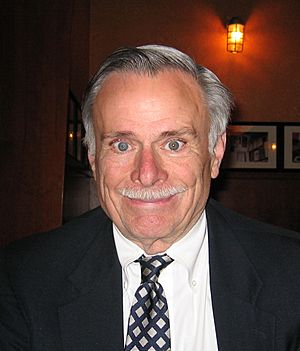John S. Waugh facts for kids
Quick facts for kids
John S. Waugh
|
|
|---|---|
 |
|
| Born | April 25, 1929 |
| Died | August 22, 2014 (aged 85) |
| Citizenship | American |
| Alma mater | Dartmouth College (A.B.) - 1949 California Institute of Technology (PhD) - 1953 Dartmouth College (ScD) - 1989 |
| Known for | Cross-polarization NMR spectroscopy in solids Computational studies of spin systems |
| Awards | Humboldt Prize (1972) Irving Langmuir Award (1976) Wolf Prize in Chemistry (1983) Linus Pauling Award (2084) Welch Award in Chemistry (2011) |
| Scientific career | |
| Fields | chemical physics |
| Institutions | Massachusetts Institute of Technology |
| Doctoral advisor | Don M. Yost |
| Doctoral students | Alexander Pines |
| Other notable students | Ulrich Haeberlen |
John Stewart Waugh (born April 25, 1929 – died August 22, 2014) was an American chemist and a special professor at the Massachusetts Institute of Technology (MIT). He is famous for making a science tool called NMR spectroscopy work for solid materials, not just liquids. This was a really big deal in science! He also created a computer program called ANTIOPE that helps scientists understand how NMR works.
Contents
What is NMR Spectroscopy?
NMR stands for Nuclear Magnetic Resonance. It's a powerful scientific method that helps scientists study the tiny parts of molecules. Think of it like a super-powered magnifying glass that uses magnets and radio waves. Before John Waugh's work, NMR was mostly used to study liquids. But many important things in the world, like bones, plastics, and even parts of our bodies, are solid.
Making NMR Work for Solids
John Waugh found a way to change how NMR worked. He developed new ideas and methods that allowed scientists to use NMR to look inside solid objects. This was a huge step forward! It meant researchers could now study the structure and properties of many new materials.
Awards and Achievements
John Waugh received many important awards for his amazing discoveries.
National Academy of Sciences
In 1974, John Waugh was chosen to be part of the National Academy of Sciences. This is a very important group of top scientists in the United States. Being elected to this academy shows that his work was highly respected by other scientists.
Wolf Prize in Chemistry
He won the important Wolf Prize in Chemistry in 1983/84. He shared this award with two other scientists, Herbert S. Gutowsky and Harden M. McConnell. They were all honored for their important work on NMR spectroscopy. John Waugh was specifically recognized for his "fundamental theoretical and experimental contributions to high resolution nuclear magnetic resonance spectroscopy in solids." This means his ideas and experiments truly changed how we understand solid materials.
Welch Award in Chemistry
In 2011, he also received the Welch Award in Chemistry. This award recognized how he completely changed NMR spectroscopy. A leader from the Welch Foundation said that John Waugh found a way to use NMR to look inside solid things. This helped scientists see the tiny parts of proteins, viruses, and other important parts of life. His amazing work is still used a lot today in many science fields like chemistry, physics, biology, and medicine.
John Stewart Waugh passed away on August 22, 2014. His contributions continue to help scientists understand the world around us.

